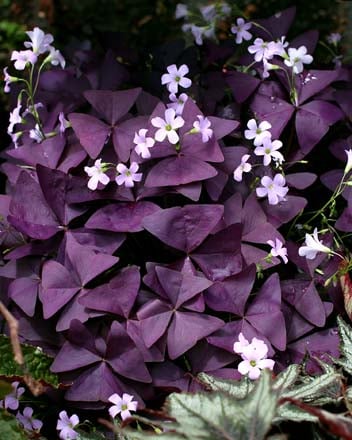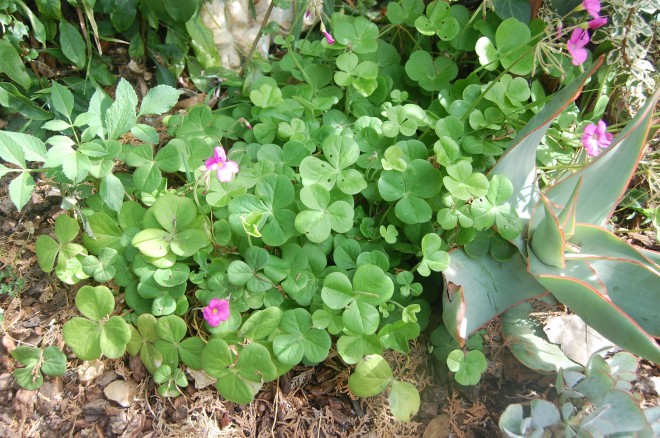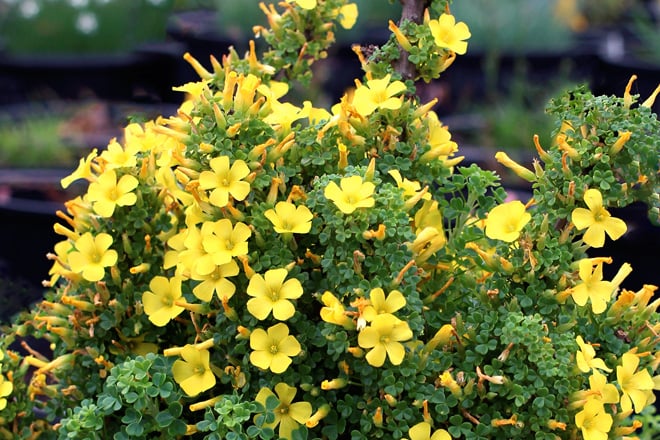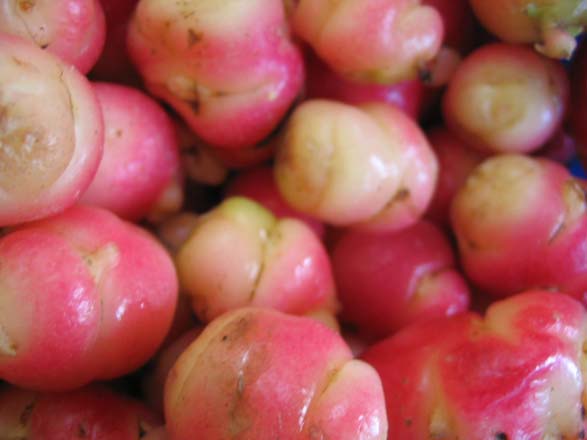
Oxalis

Contributor

To some, the mere mention of Oxalis makes their blood boil. Looking past the common, weedy types, we find a remarkable genus of some 800 known species. By far the largest member of the wood sorrel family (Oxalidaceae), members of this genus are remarkably widespread, found in virtually every part of the world outside of the polar regions. The diversity is especially astonishing in tropical Mexico, Brazil, and South Africa.
The leaves of many Oxalis species are reminiscent of clover, and in those species that contain three obovate and top-notched leaflets (arranged palmately) it’s easy to see a resemblance. One of the more curious characteristics of certain shade-loving Oxalis species (as with the burgundy O. triangularis) is their tendency to alter their leaf angle in response to light intensity. This response, which can even cause leaves to close to overcome photoinhibition, which is a decrease in the efficiency of photosynthesis when plants are exposed to an overabundance of light.

Wood Sorrel
The most common wood sorrel for West Coast gardeners is the native Oxalis oregana. Its common name, redwood sorrel, references its ability to thrive under redwood trees where little else but ferns will grow. It prefers shady, cool, and moist conditions but is remarkably tough. Mountain wood sorrel, O. montana, is a common East Coast species, a perennial herb that grows in patches connected by subterranean rhizomes producing clumps of stemless leaves that grow to about four inches high. This plant is a shade-tolerant climax species that grows in mature forests.
Oxalis acetosella, also referred to as common wood sorrel and a popular Irish shamrock, owes its species name to one of the most notable compounds found in this genus: oxalic acid. Oxalic acid gives the bright green, trifoliate leaves a mild sour taste. The Kiowa tribe reportedly chewed the leaves to alleviate thirst on long trips, the Cherokee ate them to alleviate sore throats, and the Iroquois used the plant to help with fever, cramps, and nausea. Its dried leaves may be used to make a lemony-tasting tea.
Some concern has been raised about the toxicity of oxalic acid in humans. In very large amounts, it is considered lightly toxic, interfering with proper digestion. In truth, this compound is found in more commonly consumed foods such as grapefruit, spinach, chives, broccoli, and rhubarb, among many others. General scientific consensus holds that actual poisoning from oxalic acid in persons with normal kidney function is wildly improbable.

World-Wide Oxalis
There are many fabulous Oxalis found in South Africa, one of our mediterranean-climate cousins. Take the vigorous but well-behaved Oxalis hirta, for example. This late-fall through spring bloomer features bright green, tightly held oblong leaves and 3/4-inch magenta-pink flowers. The low, spreading foliage and colorful flowers are especially welcome during the winter months. Oxalis versicolor varieties are well-known in the trade, but one has a unique name—and look—to match. Oxalis versicolor ‘Candy Cane’ forms a low bush that in summer sports upward, trumpet-shaped white flowers with a twisting peppermint-like red stripe. The look is both comical and pretty, but like others in this species, it’s a tough little customer. Being from South Africa, it pops up in the winter, blooms in the early spring, and goes dormant in summer.
South America is home to many great Oxalis species. Most recognizable is O. triangularis, with its large burgundy leaves and sprays of tiny white flowers. It’s a shade-lover and is around during spring and summer, going dormant in winter. Another unique species from this part of the world is O. tetraphylla ‘Iron Cross’. It derives its colorful name from the burgundy bands at the center of each of the four leaves. The distinctive foliage and the reddish-pink flowers in summer give it that certain wow factor. Hailing from Mexico, it likes the sun and has a growth habit similar to the common wood sorrel.
Another wood sorrel native to Central America is the vibrant green, shamrock-like O. latifolia. Stemless, it grows from small bulbs and spreads via stolons. Its lime-green foliage is a standout, with vibrant pink flowers in summer a bonus.

Not every Oxalis is low-growing. The aptly named O. gigantea forms an upright shrub that can reach eight feet and sports yellow flowers in spring. This Chilean native is hard to find but gives an idea of the broad range of forms this genus can take.

Please Pass the Oca
It isn’t just the leaves of some Oxalis that are edible. O. tuberosa was initially cultivated in regions of the Andes for its potato-like roots or tubers. Oca, as it is known there, was introduced to Europe in 1830 as a competitor to the potato. In New Zealand, the tubers are so common they are simply known as New Zealand yams and grow in a range of colors. In Mexico, oca is eaten raw with salt, lemon, and hot pepper. The tubers are a good source of beta carotene and energy-dense carbohydrates.
Share:
Social Media
Garden Futurist Podcast
Most Popular
Videos
Topics
Related Posts

Low Maintenance Gardens – Better for Pollinators and People
Autumn 2022 “I come out every day. It’s therapy, my meditation.” Janet’s young garden transformed from overgrown, invasive plants to mostly natives. The dailiness of

Calochortophilia: A Californian’s Love Affair with a Genus
Summer 2022 I can chart the progression of my life by Calochortus. For the last two decades, at least. As a teenage girl growing up

Pacific Plant People: Carol Bornstein
Spring 2022 Public gardens play a key role in demonstrating naturalistic planting design, selecting native and adapted plants for habitat, and testing techniques for reducing

Add Year-Round Interest and Winter Blooms for Pollinators
Spring 2022 This article was created from an Interview by Merrill Jensen with Neil Bell in the Summer of 2021 for our Pacific Plant People











Responses